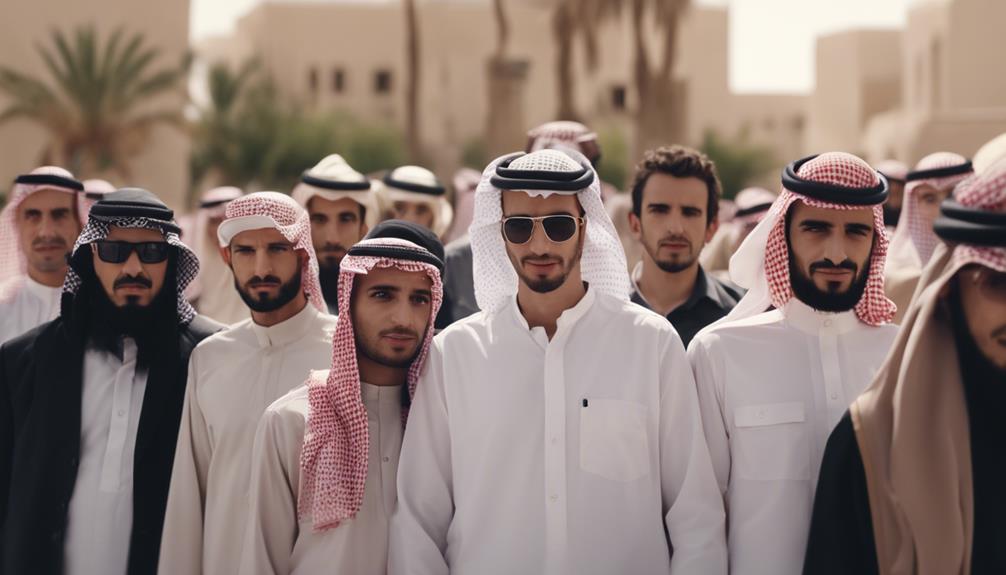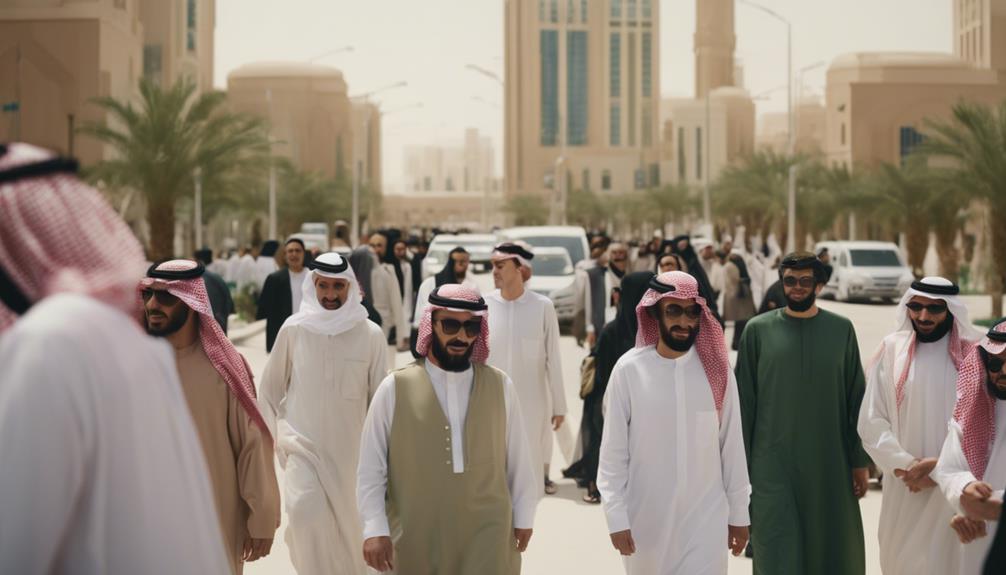With a rapidly growing population and shifting demographics, Saudi Arabia faces a critical juncture in its development trajectory. The interplay between population dynamics, economic stability, and sustainable growth presents a complex challenge that necessitates a nuanced approach.
By examining the trends, implications, and policy interventions related to managing population dynamics, a clearer picture emerges of the path ahead for the Kingdom. As we delve into the various facets of this multifaceted issue, it becomes evident that proactive planning and strategic foresight are imperative for Saudi Arabia to navigate the complexities of its demographic landscape.
Population Growth Trends and Challenges

The escalating population growth in Saudi Arabia poses significant challenges for the nation's socio-economic development and infrastructure. With rapidly increasing population projections and urbanization, the demand for housing, healthcare, education, and employment opportunities is intensifying. Saudi Arabia's fertility rates have been historically high, contributing to this population surge. However, there is also a noticeable shift towards an aging population, which brings forth its own set of challenges related to healthcare and pension systems.
Urbanization plays a crucial role in this population growth, as more people are moving from rural areas to cities in search of better opportunities. This mass migration strains urban infrastructure and services, leading to issues like congestion, inadequate housing, and increased demand for utilities. Managing the balance between urban development and preservation of natural resources becomes paramount in ensuring sustainable growth amidst these demographic shifts.
Addressing these challenges requires strategic planning, investment in infrastructure, and policies that support balanced population growth and sustainable development.
Demographic Transition and Implications
Amidst Saudi Arabia's evolving population dynamics, the demographic transition brings forth significant implications for the nation's future development and societal structure. As the country undergoes demographic shifts, characterized by declining fertility rates and increasing life expectancy, it is experiencing population aging at a rapid pace. This phenomenon poses various challenges and opportunities for Saudi Arabia.
The declining fertility rates indicate a shift towards smaller family sizes, impacting traditional family structures and altering the dependency ratio. With fewer children being born, there may be implications for the future workforce and social support systems. Furthermore, the increasing life expectancy is contributing to a larger elderly population, necessitating the provision of adequate healthcare, social services, and pension systems to cater to their needs.
Addressing the implications of population aging requires strategic planning and policy interventions to ensure sustainable development and social cohesion. By understanding the dynamics of demographic transition, Saudi Arabia can adapt its policies to effectively manage the consequences of changing population patterns.
Government Policies and Interventions

In response to the demographic transition and its implications, Saudi Arabia has implemented a series of targeted government policies and interventions aimed at managing the changing population dynamics. These government initiatives encompass a range of strategies to address the challenges and opportunities presented by shifts in population trends.
One key focus has been on enhancing social programs to support families, women, and youth. This includes initiatives to improve access to healthcare, education, and social services to ensure the well-being and development of all segments of the population.
Moreover, the government has introduced policies to promote family stability and support, such as marriage counseling services and financial incentives for marriage and family planning. These efforts aim to address demographic imbalances and promote sustainable population growth.
Additionally, investments in youth development programs, vocational training, and job creation initiatives are geared towards harnessing the demographic dividend and preparing the younger generation for future roles in the economy and society. By implementing these government interventions, Saudi Arabia seeks to navigate the demographic transition effectively and harness the potential benefits of a changing population landscape.
Economic Impact and Opportunities
With the evolving population dynamics in Saudi Arabia, significant economic impacts and opportunities have emerged, shaping the country's future trajectory. The growing population presents a dual challenge and opportunity for the Saudi economy. On one hand, it puts pressure on the job market as more individuals enter the workforce, increasing the demand for employment opportunities. However, this demographic shift also signifies a vast pool of human capital that can drive economic growth and innovation.
To address the need for job creation, Saudi Arabia has been actively promoting investment opportunities in various sectors such as technology, renewable energy, and tourism. The Vision 2030 plan, a strategic roadmap for the country's future development, emphasizes diversification and expansion of the economy beyond oil dependency. This shift opens doors for both local and foreign investors to explore new ventures and contribute to the creation of sustainable employment opportunities.
Sustainable Development Strategies

The implementation of sustainable development strategies is pivotal in ensuring long-term environmental and social prosperity in Saudi Arabia. To achieve this, the country is increasingly focusing on green initiatives and sustainable urban planning. Green initiatives encompass a wide range of projects aimed at reducing carbon footprints, conserving natural resources, and promoting renewable energy sources. Saudi Arabia, with its abundant sunlight, is well-positioned to harness solar power through initiatives like the King Abdullah City for Atomic and Renewable Energy (KACARE). Additionally, the country is actively investing in wastewater treatment plants to ensure efficient water usage and conservation.
Urban planning plays a crucial role in sustainable development by promoting smart growth, efficient transportation systems, and green spaces within cities. Saudi Arabia's Vision 2030 emphasizes the development of sustainable cities that prioritize walkability, green building practices, and public transportation networks. Initiatives like the Riyadh Metro project are key examples of sustainable urban planning efforts aimed at reducing traffic congestion and air pollution. By integrating green initiatives and sustainable urban planning, Saudi Arabia is working towards a more environmentally friendly and socially responsible future.
Frequently Asked Questions
How Does Saudi Arabia's Population Growth Compare to Other Countries in the Region?
When conducting a comparative analysis of population growth in the region, Saudi Arabia's demographic trends stand out. The country's population growth rate surpasses that of its neighboring nations, reflecting unique dynamics influencing its demographic landscape.
What Cultural Factors Are Influencing Family Planning Decisions in Saudi Arabia?
Cultural norms play a significant role in shaping family planning decisions in Saudi Arabia. These norms, deeply rooted in tradition and religion, impact fertility rates by influencing attitudes towards contraception, family size, and gender roles.
Are There Any Specific Challenges Related to Urbanization and Population Density in the Country?
Challenges related to urbanization and population density in Saudi Arabia include strain on urban infrastructure and resource allocation. Managing rapid urban growth is essential to ensuring sustainable development and quality of life for residents.
How Does the Government Ensure That Marginalized Populations Are Included in Population Management Strategies?
In ensuring social equity and effective population management strategies, governments must prioritize inclusion strategies for marginalized populations. By addressing their unique needs and circumstances within broader population dynamics, sustainable and inclusive development can be achieved.
What Role Do International Partnerships Play in Shaping Saudi Arabia's Population Dynamics?
Global partnerships are vital in shaping Saudi Arabia's population dynamics. Through data sharing and foreign aid, countries collaborate on education initiatives, influencing migration patterns, healthcare access, and economic opportunities. These partnerships contribute to informed policies and sustainable development.
Conclusion
In conclusion, managing Saudi Arabia's population dynamics is crucial for sustainable development and economic growth. Understanding population growth trends, implementing government policies, and promoting sustainable development strategies are essential to address the challenges posed by demographic transition.
By focusing on these areas, Saudi Arabia can capitalize on the economic opportunities presented by a growing population while ensuring long-term stability and prosperity for its society.

